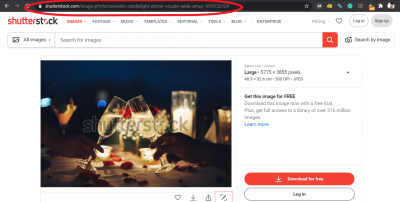Thinking about turning your photography skills into a source of income? Becoming a Shutterstock model might be just the opportunity you’re looking for. Whether you’re an aspiring professional or someone who loves taking great photos, contributing to Shutterstock can help you reach a global audience and earn money. The process is straightforward, but it’s important to understand what
Understanding Shutterstock’s Model Submission Requirements

Before you jump into submitting your photos or videos, it’s crucial to understand Shutterstock’s specific requirements for models. They want high-quality, authentic, and versatile content, and this extends to the models featured in your imagery. Here’s what you need to know:
Model Release Forms
- For photos or videos featuring people, a signed model release form is mandatory. This legal document grants Shutterstock permission to use the images commercially.
- Make sure the model release form is properly filled out, accurate, and signed by the model or guardian if the model is underage.
- Incorrect or missing releases can lead to rejection of your submissions, so double-check this step.
Photo and Video Quality
Shutterstock is all about professional-looking content. Here’s what they expect:
- High resolution: Images should be sharp and clear, ideally 4MP or higher.
- Good lighting: Well-lit photos that accurately represent the subject.
- Neutral backgrounds: Especially for model shots, simple backgrounds help focus on the subject.
- Authenticity: Avoid overly staged or unnatural poses. Natural expressions and candid moments are preferred.
Model Diversity and Representation
Shutterstock values diversity and aims to showcase a wide range of people. When submitting images, consider:
- Including models of different ages, ethnicities, body types, and backgrounds.
- Capturing a variety of emotions and authentic interactions.
- Ensuring your models look natural and comfortable in their environment.
Content Guidelines and Restrictions
There are certain types of content that Shutterstock doesn’t accept:
| Prohibited Content | Notes |
|---|---|
| Violent or graphic imagery | Content that depicts harm or violence is not allowed. |
| Illegal activities or substances | Any content promoting illegal acts will be rejected. |
| Inappropriate or adult content | Explicit or suggestive images are not permitted for model photos. |
| Brands or logos without permission | Be cautious about including identifiable trademarks or logos in your images. |
In summary, understanding these requirements helps you produce content that meets Shutterstock’s standards and increases your chances of acceptance. Pay attention to technical quality, authenticity, diversity, and legal aspects, and you’ll be well on your way to becoming a successful Shutterstock model!
Preparing Your Portfolio for Stock Photography
Alright, so you’re thinking about becoming a Shutterstock model and diving into the world of stock photography? Great choice! But before you start snapping away, it’s super important to prepare a solid portfolio. Think of your portfolio as your digital storefront—it’s what attracts buyers and showcases your best work.
First things first, quality over quantity is the name of the game. You don’t need hundreds of photos, but the ones you do include should be sharp, well-lit, and professionally composed. Take the time to curate your best shots—those that tell a story or evoke emotion. Remember, stock photos are often used to illustrate concepts, so versatility is key.
Next, consider your diversity. Buyers look for variety—people, places, objects, concepts—so include different subjects and styles. For example, have a mix of portraits, lifestyle shots, business scenes, and nature images. This broadens your portfolio’s appeal and increases your chances of making sales.
Focus on trends and what’s currently in demand. Browse Shutterstock’s popular categories or use tools like Google Trends to see what people are searching for. Incorporate those themes into your portfolio to stay relevant and increase visibility.
Another vital tip is to pay attention to model releases. If your photos include recognizable people, you’ll need signed model releases to sell those images legally. Prepare these documents in advance so you’re ready when the opportunity comes.
Finally, organize your portfolio neatly. Use clear filenames, categorize your images, and upload at a steady pace. A well-organized portfolio not only makes it easier for buyers to find what they want but also demonstrates your professionalism. Remember, first impressions count!
Tips for Shooting High-Quality Stock Photos
Shooting stock photos might seem straightforward, but creating images that sell consistently requires some finesse. Here are some tips to help you produce high-quality, appealing stock photos that stand out:
- Use natural light whenever possible. Soft, diffused daylight helps create flattering images without harsh shadows. Shooting outdoors or near large windows can give your photos a fresh, natural look.
- Invest in a good camera and lens. While smartphone cameras are improving, a DSLR or mirrorless camera with a sharp lens can really elevate your images. Focus on clarity, detail, and color accuracy.
- Pay attention to composition. Follow basic rules like the rule of thirds, leading lines, and framing. Keep the subject in focus and avoid clutter that distracts from the main idea.
- Mind the background. Clean, uncluttered backgrounds work best. If shooting people, ensure backgrounds are neutral or add context that enhances the story.
- Focus on storytelling. Stock photos should evoke a specific concept or emotion. Think about the message you want to convey—whether it’s teamwork, happiness, or productivity—and shoot accordingly.
- Keep editing simple. Basic adjustments like brightness, contrast, and sharpness can make your photos pop. Avoid over-editing or applying heavy filters—authenticity sells better.
- Be mindful of model releases and property rights. As mentioned earlier, if your shot includes people or private property, secure the necessary permissions.
Finally, don’t be discouraged if your first few shots don’t sell. Practice makes perfect! Keep experimenting with different subjects, lighting, and angles. Over time, you’ll develop your style and understanding of what sells best on platforms like Shutterstock. Happy shooting!
Uploading and Tagging Your Photos on Shutterstock
So, you’ve taken some great photos and you’re ready to share them with the world. Uploading your images to Shutterstock is pretty straightforward, but to really get noticed and boost your chances of making sales, you need to be strategic about how you upload and tag your photos.
First, before you upload, make sure your images meet Shutterstock’s technical requirements. They prefer high-resolution images (at least 4 megapixels), in JPEG format, with good lighting and clarity. Editing your photos for color correction or cropping can really make them pop!
Once your images are ready, log into your contributor account and head over to the upload section. You can upload files individually or in batches—batch uploading saves time if you have a lot of photos to add.
Now, onto the most critical part: tagging. Think of tags as the way potential buyers find your images. Use descriptive, relevant keywords that accurately reflect the content of your photo. For example, if you upload a picture of a smiling woman drinking coffee, tags could include: woman, coffee, breakfast, smiling, morning, casual.
Here are some tips for effective tagging:
- Be specific: Instead of generic tags like “people,” use detailed ones like “businesswoman,” “teen girl,” or “elderly man.”
- Use synonyms: People might search for “car” or “automobile,” so include both.
- Include location tags: If your photo features a recognizable place, add that location, like “Paris” or “New York.”
- Avoid overstuffing: Don’t add irrelevant tags just to get more exposure—that can hurt your credibility and search rankings.
Besides tags, you’ll also need to select the appropriate categories for your photos. This helps Shutterstock categorize your images correctly and makes it easier for buyers to find what they’re looking for.
Finally, write a clear and concise description of your photo. This not only helps with search optimization but also gives buyers context about your image. Be honest and avoid hype—accuracy is key.
Once everything looks good, hit submit, and your photo will go through Shutterstock’s review process. Remember, patience is a virtue—most images are reviewed within a few days, and if approved, they’ll be live and ready to sell!
Best Practices for Increasing Your Visibility and Sales
Getting your photos approved is just the beginning. To truly succeed as a Shutterstock model, you want to maximize your visibility and boost your sales. Here are some tried-and-true strategies that can help you stand out in the crowded marketplace:
1. Consistency is key
Uploading regularly keeps your portfolio fresh and signals to Shutterstock that you’re an active contributor. Aim to upload new images consistently—whether it’s weekly or bi-weekly—to build momentum and increase your chances of being featured.
2. Focus on trending topics and evergreen content
Stay aware of current trends—like remote work, sustainability, or health and wellness—and create images around these themes. At the same time, don’t neglect evergreen topics like business, lifestyle, or nature, which always have demand.
3. Optimize your keywords and descriptions
Use your best keywords wisely. Think about what buyers might search for and incorporate those terms naturally into your descriptions. Quality keywords improve search ranking and visibility.
4. Diversify your portfolio
Offer a variety of images—people, objects, landscapes, concepts—so you appeal to a broader audience. This increases your chances of sales across different categories.
5. Pay attention to quality and uniqueness
High-quality, well-composed images tend to perform better. Also, aim to create unique content that stands out—think outside the box and offer fresh perspectives.
6. Engage with the Shutterstock community
Participate in forums, read other contributors’ tips, and learn from their success stories. Sometimes, joining contests or challenges can give your portfolio extra exposure.
7. Promote your portfolio outside Shutterstock
Share your work on social media platforms, personal websites, or blogs. Building an online presence can attract more buyers and increase your sales on Shutterstock.
Remember, patience and persistence pay off. The more you contribute and refine your approach, the more your visibility will grow, leading to higher sales and a thriving modeling career on Shutterstock.
FAQs About Becoming a Shutterstock Model
Thinking about jumping into the world of stock photography as a Shutterstock model? You probably have some questions floating around, and that’s totally normal. Let’s clear up some of the most common ones so you can feel more confident about taking the next step.
Q: Do I need professional photography experience to become a Shutterstock model?
Nope! You don’t need to be a professional model or photographer. Shutterstock welcomes anyone who can provide high-quality, natural-looking photos. The key is to focus on good lighting, clear images, and authentic expressions. If you’re comfortable in front of the camera and can deliver clean, well-lit shots, you’re already on the right track.
Q: What kind of photos does Shutterstock look for?
They want a diverse range of images that can be used across different industries—business, lifestyle, technology, health, and more. Think about:
- People using devices like smartphones or laptops
- Friendly, natural expressions
- Everyday activities like cooking, exercising, or working
- Diverse backgrounds and ethnicities to reflect global audiences
Remember, authenticity is key. Avoid overly staged or cheesy poses—aim for natural, relatable moments.
Q: How much money can I make as a Shutterstock model?
It varies depending on the number of downloads your images get and the license type. Shutterstock pays a royalty percentage per download, which can range from a few cents to several dollars. Over time, with a solid portfolio, many contributors earn a steady income. The more high-quality images you upload, the better your chances of earning more.
Q: Do I need to sign a model release form?
Yes. Shutterstock requires all models in their photos to sign a model release form, granting permission for commercial use. If you’re photographing others, make sure they sign the release before submitting the images. For yourself, you’ll typically sign a release during the upload process or through the Shutterstock contributor portal.
Q: Can I submit photos taken with my smartphone?
Absolutely! While professional gear can help, smartphone cameras nowadays produce excellent quality images. Just ensure good lighting, stability, and focus. High-resolution photos taken with a good smartphone can perform just as well as those shot with professional cameras.
Q: How long does it take to start earning money?
It depends on how quickly you upload quality photos and how popular they become. Once your images are approved and live, you might see your first earnings within a few weeks or months, especially if your images resonate with buyers. Consistency and quality are your best friends here.
Conclusion and Final Tips for Success
Becoming a Shutterstock model can be an exciting journey that allows you to turn your creativity into income. It’s all about producing authentic, high-quality images that meet the needs of various buyers. Remember, everyone starts somewhere, and the key is to stay consistent and patient.
Here are some final tips to help you succeed:
- Focus on authenticity: Natural expressions and relatable scenes perform best.
- Research trends: Keep an eye on popular themes and subjects that buyers are searching for.
- Invest in good lighting: Clear, well-lit photos stand out more and get approved faster.
- Diversify your portfolio: Include a variety of subjects, backgrounds, and styles to reach a broader audience.
- Follow Shutterstock guidelines: Read their submission standards carefully to avoid rejection.
- Stay consistent: Regular uploads increase your visibility and earning potential over time.
- Engage with the community: Join forums or social media groups to learn tips and share experiences with other contributors.
Remember, patience and persistence pay off. Keep honing your photography skills, stay authentic, and don’t be afraid to experiment. Before you know it, you could be earning passive income just by doing what you love—taking great photos!


